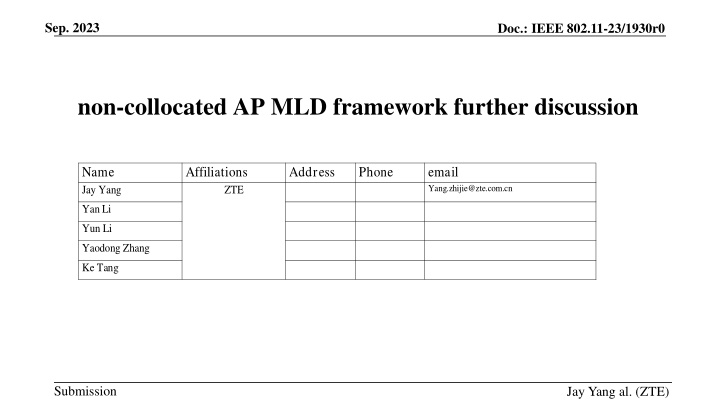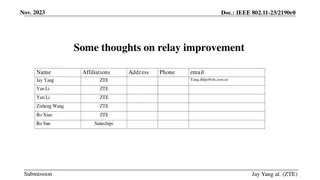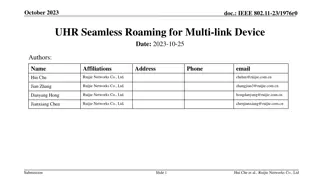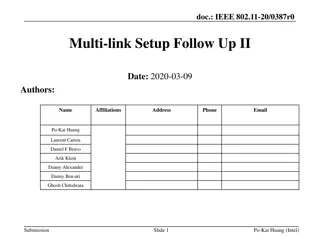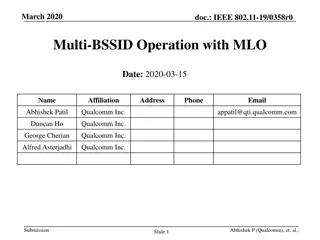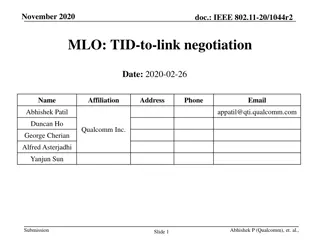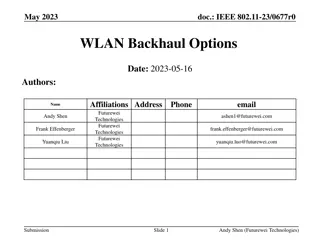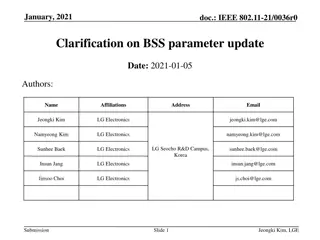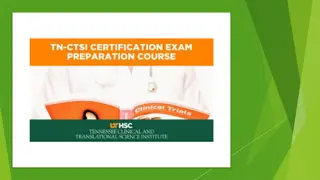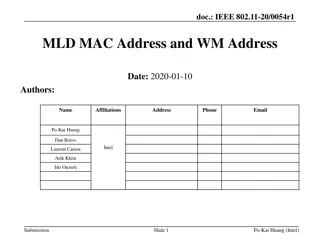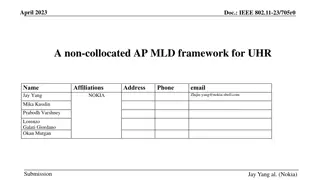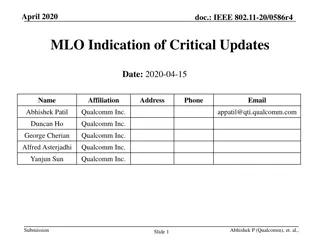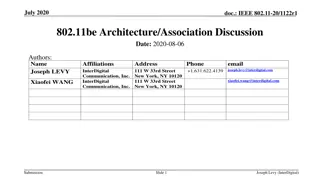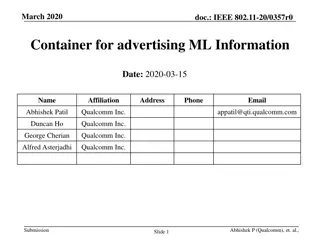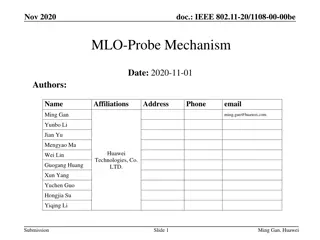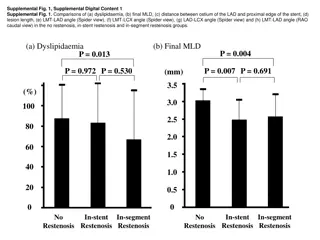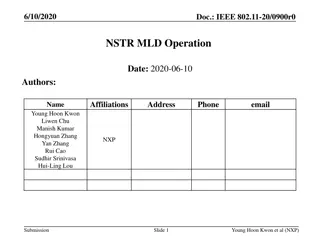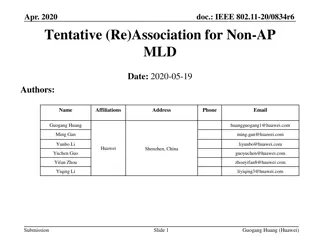Future of FTTR Products: Non-Collocated AP MLD Framework
In September 2023, IEEE 802.11-23/1930r0 discussed the use of non-collocated AP MLD framework in FTTR products for improved user experience. The framework aims to enhance Wi-Fi communication, seamless roaming, and Wi-Fi sensing integration. It simplifies AP MLD design, supports multiple links for indoor location, and reduces costs. The merit of non-collocated AP MLD lies in its compatibility with various M-AP schemes and its seamless traffic delivery capabilities.
Download Presentation

Please find below an Image/Link to download the presentation.
The content on the website is provided AS IS for your information and personal use only. It may not be sold, licensed, or shared on other websites without obtaining consent from the author.If you encounter any issues during the download, it is possible that the publisher has removed the file from their server.
You are allowed to download the files provided on this website for personal or commercial use, subject to the condition that they are used lawfully. All files are the property of their respective owners.
The content on the website is provided AS IS for your information and personal use only. It may not be sold, licensed, or shared on other websites without obtaining consent from the author.
E N D
Presentation Transcript
Sep. 2023 Doc.: IEEE 802.11-23/1930r0 non-collocated AP MLD framework further discussion Name Jay Yang Affiliations Address Phone email Yang.zhijie@zte.com.cn ZTE YanLi Yun Li YaodongZhang Ke Tang Submission Jay Yang al. (ZTE)
Sep. 2023 Doc.: IEEE 802.11-23/1930r0 Background FTTR/G.fin(Fibre-to-the room/Fibre based in-premises networking) products widely deployed in residential environment to improve user s experience. provides low latency and high reliability via fibre backhaul connection composed by one MFU and several SFUs deployed in different places each MFU and SFU has one AP MLD that provides wireless connection Submission Slide 2 Jay Yang, et al. (ZTE)
Sep. 2023 Doc.: IEEE 802.11-23/1930r0 Motivation We re looking forwards to the next generation of FTTR product that support Wi-Fi communication and sensing integration. higher manageability of the whole network seamless roaming for mobility device seamless Wi-Fi sensing to improve accuracy multiple links for in-door location simplify the design of AP MLD and reduce Wi-Fi chip set cost try to reuse current EHT AP MLD framework as much as possible Non-collocated AP MLD is the best candidate framework with the following merits Submission Slide 3 Jay Yang, et al. (ZTE)
Sep. 2023 Doc.: IEEE 802.11-23/1930r0 the merit of non-collocated AP MLD(1) simplify the design of AP MLD 3 radios on one 11be chipset is already complicated, we don t look for more radios integrated into one chipset to serve the high-ends non-AP MLD(e.g., EMLSR non-AP MLD may support more than 3 links) new AP MLD framework allow AP vendor to deploy multiple dual-radio AP MLDs in different places to provide a batch of links, to meet all kinds of high-ends non-AP MLD and IOT device requirements . seamless roaming allow non-AP MLD to set up any links at any place for the seamless traffic delivery during movement multi-link for Wi-Fi location and seamless Wi-Fi sensing possible to have multi-session for the location and Wi-Fi sensing under MLO framework Submission Slide 4 Jay Yang, et al. (ZTE)
Sep. 2023 Doc.: IEEE 802.11-23/1930r0 the merit of non-collocated AP MLD(2) compatible with other M-AP schemes: compatible with C-OFDMA,C-SR,C-TDMA,C-TWT scheme etc. if more than two links operating on the same channel. no fairness issue, UHR AP MLD High MAC coordinates the media resource access less overhead issue on the MAP coordination signaling, MAP coordination signaling can be delivered with wired backhaul,like Fibre backhaul in FTTR product. compatible with all kinds of 11be non-AP MLD and single link STA operation compatible with single link STA compatible with 11be STR non-AP MLD compatible with 11be NSTR/EMLSR/EMLMR non-AP MLD on the non-real-time operation Submission Slide 5 Jay Yang, et al. (ZTE)
Sep. 2023 Doc.: IEEE 802.11-23/1930r0 one example between UHR non-AP MLD and non- collocated AP MLD UHR AP MLD high MAC backhaul (MFU)EHT AP MLD1 backhaul AP1.2 6 GHz AP1.1 2.4 GHz UHR AP MLD (SFU)EHT AP MLD2 (SFU)EHT AP MLD3 AP2.2 6 GHz AP2.1 5 GHz AP3.2 6 GHz AP3.1 5 GHz L2 L3 L1 Submission Slide 6 Jay Yang, et al. (ZTE)
Sep. 2023 Doc.: IEEE 802.11-23/1930r0 The extension in discovery procedure UHR AP MLD assigns a unique MLD index for each EHT AP MLD EHT AP MLD assigns the link ID for the affiliated AP as it does in 11be UHR non-AP MLD can distinguish all the links via UHR link ID= <MLD index, link ID> one flag should be set in the RNR to indicate whether two reported APs within different EHT AP MLDs belongs to the same UHR AP MLD or not. All APs broadcast the same UHR AP MLD MAC address in ML element Submission Slide 7 Jay Yang, et al. (ZTE)
Sep. 2023 Doc.: IEEE 802.11-23/1930r0 one example of non-collocated AP MLD discovery UHR AP MLD high MAC EHT AP MLD1(MLD index=0) backhaul backhaul AP1.2 6 GHz AP1.1 2.4 GHz UHR AP MLD link ID=1 link ID=0 EHT AP MLD2(MLD index=1) AP2.2 6 GHz EHT AP MLD3(MLD index=2) AP2.1 5 GHz AP3.2 6 GHz link ID=1 AP3.1 5 GHz link ID=1 link ID=0 link ID=0 UHR link ID =(1,0) Submission Slide 8 Jay Yang, et al. (ZTE)
Sep. 2023 Doc.: IEEE 802.11-23/1930r0 the extension in MLO setup procedure UHR non-AP MLD may set up multi-link with different EHT AP MLDs belonging to the same UHR AP MLD (re)association request may carry multiple ML elements authentication, association, 4HS frames are transparently delivered over EHT AP MLD authentication, association, 4HS shall be exchanged between UHR non-AP MLD and UHR AP MLD high MAC one signaling in authentication frame sent by non-AP MLD to indicate it s a UHR non-AP MLD or EHT non-AP MLD, so that the EHT AP MLD can decide to handle it locally or forward to UHR AP MLD high MAC Submission Slide 9 Jay Yang, et al. (ZTE)
Sep. 2023 Doc.: IEEE 802.11-23/1930r0 one example of setting-up procedure in non-collocated AP MLD Submission Slide 10 Jay Yang, et al. (ZTE)
Sep. 2023 Doc.: IEEE 802.11-23/1930r0 AID assignment in non-collocated AP MLD framework There will be some challenge for 12-bit AID field in larger scale non-collocated AP MLD network thousands of STAs may associate with the same non-collocated AP MLD in larger scale network only allow maximum 2K STAs association at the same time according to current length of AID field AID field needs some extension and is also compatible with legacy STA/non-AP MLD UHR AID =<MLD index, AID> UHR AP MLD high MAC assigns and recycles MLD index of each EHT AP MLD. multiple EHT AP MLDs coordinate to assign a common AID to the set-up link of UHR non-AP MLD non-AP MLD has the same AID on different set-up links Submission Slide 11 Jay Yang, et al. (ZTE)
Sep. 2023 one example of the AID assignment by non-collocated AP MLD Doc.: IEEE 802.11-23/1930r0 UHR AP MLD high MAC EHT AP MLD1(MLD index=0) backhaul backhaul AP1.2 6 GHz AP1.1 2.4 GHz UHR AP MLD link ID=0 link ID=1 EHT AP MLD2(MLD index=1) AP2.2 6 GHz EHT AP MLD3(MLD index=2) AP2.1 5 GHz AP3.2 6 GHz link ID=1 AP3.1 5 GHz link ID=1 link ID=0 link ID=0 AID=100 AID=100 UHR AID=<1,100> or <2,100> UHR STA Submission Slide 12 Jay Yang, et al. (ZTE)
Sep. 2023 Doc.: IEEE 802.11-23/1930r0 PPDU delivery with NSTR/EMLSR/EMLMR non-AP MLD Due to the latency in the backhaul, run-time coordination will encounter some challenge. start time/end time alignment is hard to support for NSTR non-AP MLD another aspect, less commercial AP MLD support ending time alignment therefore, non-collocated AP MLD frame may not support ending time alignment non-run time coordination in the backhaul make it possible for the non-overlap PPDU delivery on single link two EHT AP MLDs coordinate a non-overlap time slot for PPDU delivery on single link when STA operates in NSTR/EMLSR/EMLMR mode also,support UL traffic delivery on more than 1 link when the STA operates in NSTR mode as it is in 11be. TSF synchronization among different EHT AP MLDs in UHR AP MLD? No requirement. Submission Slide 13 Jay Yang, et al. (ZTE)
Sep. 2023 Doc.: IEEE 802.11-23/1930r0 one example of the PPDU delivery between NSTR/EMLSR/EMLMR non-AP MLD and non-collocated AP MLD T1 time slot negotiation on backhaul T3 STA1 UHR UHR AP1(EHT AP MLD1) T2 AP MLD non- AP MLD STA2 AP2(EHT AP MLD2) Fig.1 single link PPDU delivery between NSTR/EMLSR/EMLMR non-AP MLD and non-collocated AP MLD T1 STA1 UHR UHR AP1(EHT AP MLD1) T1 AP MLD non- AP MLD STA2 AP2(EHT AP MLD2) Fig.2 multi-link UL traffic delivery between NSTR non-AP MLD and non-collocated AP MLD Submission Slide 14 Jay Yang, et al. (ZTE)
Sep. 2023 Doc.: IEEE 802.11-23/1930r0 summary introduce the current FTTR product framework and next generation of FTTR development direction describe the motivation of non-collocated AP MLD framework introduce a simple approach to have non-collocated AP MLD framework based on EHT AP MLD framework the extension for non-collocated AP MLD in discovery, association, AID assignment and PPDU delivery procedure Submission Slide 15 Jay Yang, et al. (ZTE)
Sep. 2023 Doc.: IEEE 802.11-23/1930r0 THANK YOU Submission
Sep. 2023 Doc.: IEEE 802.11-23/1930r0 reference [1] 11-23-0480-00-0uhr-uhr-proposed-par.pdf [2] 11-22-1910-03-0uhr-seamless-roaming-for-uhr.pptx [3] 11-22-1512-00-0uhr-multi-ap-coordination-for-uhr.pptx [4] ITU-T G.9940(G.fin-SA) High speed fibre-based in-premises transceivers system architecture Submission Slide 17 Jay Yang, et al. (ZTE)
Sep. 2023 Doc.: IEEE 802.11-23/1930r0 SP1 Do you agree UHR group should have some further study on the non-collocated AP MLD framework? Y: N: A: Submission Slide 18 Jay Yang, et al. (ZTE)
